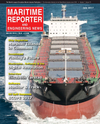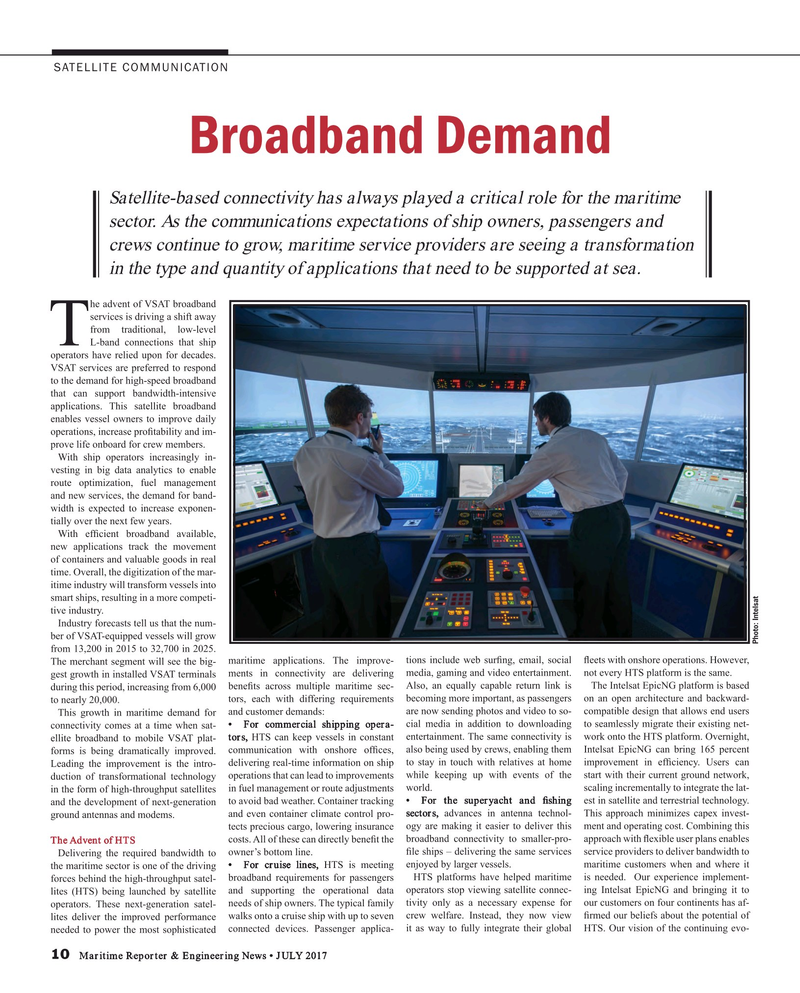
Page 10: of Maritime Reporter Magazine (July 2017)
The Marine Communications Edition
Read this page in Pdf, Flash or Html5 edition of July 2017 Maritime Reporter Magazine
SATELLITE COMMUNICATION
Broadband Demand
Satellite-based connectivity has always played a critical role for the maritime sector. As the communications expectations of ship owners, passengers and crews continue to grow, maritime service providers are seeing a transformation in the type and quantity of applications that need to be supported at sea.
he advent of VSAT broadband services is driving a shift away from traditional, low-level
TL-band connections that ship operators have relied upon for decades.
VSAT services are preferred to respond to the demand for high-speed broadband that can support bandwidth-intensive applications. This satellite broadband enables vessel owners to improve daily operations, increase pro? tability and im- prove life onboard for crew members.
With ship operators increasingly in- vesting in big data analytics to enable route optimization, fuel management and new services, the demand for band- width is expected to increase exponen- tially over the next few years.
With ef? cient broadband available, new applications track the movement of containers and valuable goods in real time. Overall, the digitization of the mar- itime industry will transform vessels into smart ships, resulting in a more competi- tive industry.
Industry forecasts tell us that the num- ber of VSAT-equipped vessels will grow
Photo: Intelsat from 13,200 in 2015 to 32,700 in 2025. maritime applications. The improve- tions include web sur? ng, email, social ? eets with onshore operations. However,
The merchant segment will see the big- gest growth in installed VSAT terminals ments in connectivity are delivering media, gaming and video entertainment. not every HTS platform is the same. during this period, increasing from 6,000 bene? ts across multiple maritime sec- Also, an equally capable return link is The Intelsat EpicNG platform is based tors, each with differing requirements becoming more important, as passengers on an open architecture and backward- to nearly 20,000.
This growth in maritime demand for and customer demands: are now sending photos and video to so- compatible design that allows end users • For commercial shipping opera- cial media in addition to downloading to seamlessly migrate their existing net- connectivity comes at a time when sat- tors, HTS can keep vessels in constant entertainment. The same connectivity is work onto the HTS platform. Overnight, ellite broadband to mobile VSAT plat- forms is being dramatically improved. communication with onshore of? ces, also being used by crews, enabling them Intelsat EpicNG can bring 165 percent delivering real-time information on ship to stay in touch with relatives at home improvement in ef? ciency. Users can
Leading the improvement is the intro- duction of transformational technology operations that can lead to improvements while keeping up with events of the start with their current ground network, in the form of high-throughput satellites in fuel management or route adjustments world. scaling incrementally to integrate the lat- and the development of next-generation to avoid bad weather. Container tracking • For the superyacht and ? shing est in satellite and terrestrial technology. and even container climate control pro- sectors, advances in antenna technol- This approach minimizes capex invest- ground antennas and modems. tects precious cargo, lowering insurance ogy are making it easier to deliver this ment and operating cost. Combining this costs. All of these can directly bene? t the broadband connectivity to smaller-pro- approach with ? exible user plans enables
The Advent of HTS
Delivering the required bandwidth to owner’s bottom line. ? le ships – delivering the same services service providers to deliver bandwidth to the maritime sector is one of the driving • For cruise lines, HTS is meeting enjoyed by larger vessels. maritime customers when and where it broadband requirements for passengers HTS platforms have helped maritime is needed. Our experience implement- forces behind the high-throughput satel- lites (HTS) being launched by satellite and supporting the operational data operators stop viewing satellite connec- ing Intelsat EpicNG and bringing it to needs of ship owners. The typical family tivity only as a necessary expense for our customers on four continents has af- operators. These next-generation satel- lites deliver the improved performance walks onto a cruise ship with up to seven crew welfare. Instead, they now view ? rmed our beliefs about the potential of needed to power the most sophisticated connected devices. Passenger applica- it as way to fully integrate their global HTS. Our vision of the continuing evo- 10 Maritime Reporter & Engineering News • JULY 2017
MR #7 (10-17).indd 10 MR #7 (10-17).indd 10 7/6/2017 10:56:12 AM7/6/2017 10:56:12 AM

 9
9

 11
11
